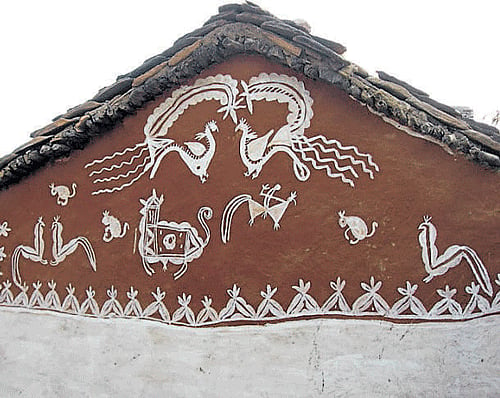Art has long since been used to fortify the richness and significance of Indian festivals. One such rendition from Punjab has contributed to the cultural treasure of India.
During festivals like Dussehra, Karva Chauth, Holi or Diwali in Punjab, mud walls of rural houses are enhanced with paintings to conjure blessings of Lakshmi, the goddess of wealth. These rustic, patiently-created and joyfully rendered forms, assembled mainly on walls, create an auspicious environment within the household in the midst of festivities.
Similar to alpona in Bengal, where rice paste is used to decorate floors during festive occasions, or other similar practices across the states of India like padi-kolam in Kerala, aripana in Bihar, rangoli in Karnataka and mandana in Rajasthan, this art is known as chowk-poorana or chowkpurana in Punjab and is given shape by the peasant women of the state who have learnt it from their mothers and elderly women, who also had found artistic expression on mud walls through this art. Because of their enthusiasm and craft, the seemingly simple walls become eye-catching surfaces.
Specific tree motifs, flowers, ferns, creepers, plants, peacocks, palanquins, geometric patterns along with vertical, horizontal and oblique lines result in a confluence of simplicity, intricacy and abstraction, lending credence to the importance of this artistry in the lives of the rural folk.
This beautification of walls also creates a sense of opulence and devotion in their surroundings. Chowkpurana also seems to represent positivity in subtle ways, and seeing these compositions directly will definitely show an onlooker or a householder the spellbinding and energising effect it can have on its surroundings.
Earlier, these creations were meant to ward off evil spirits, however, later on, their use merged with rituals, worship and decoration.
Becoming a platform of creative expression for the women of Punjab who are influenced by customs and traditions of the region, it gives them a chance to display their skills, beautify their own homes and hence, the society at large.
In addition to mud walls, courtyards are also decorated in colours such as white, Indian red and ultramarine blue using a piece of cloth. This process of creation is not as simple as it looks, because only those learned in the art will be able to make elaborate or simplified versions in perfection.
In the age of digital illustrations, these simple and beautiful representations on mud surfaces stand out for their originality. This originality in its truest state should be cherished and nurtured as they will be passed down through generations.

